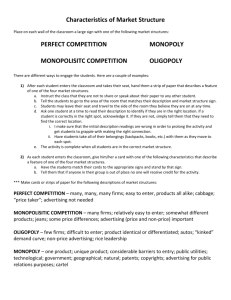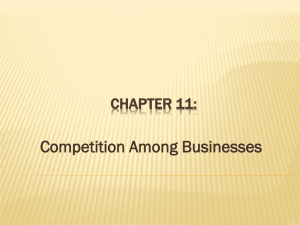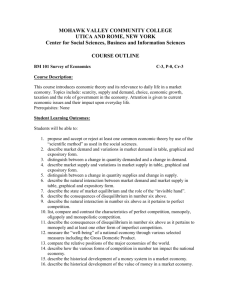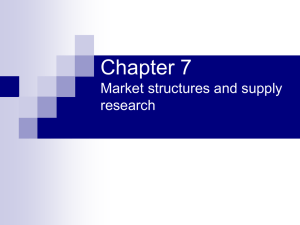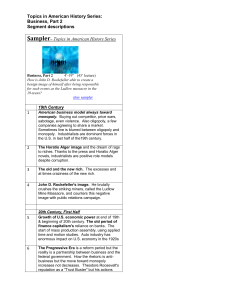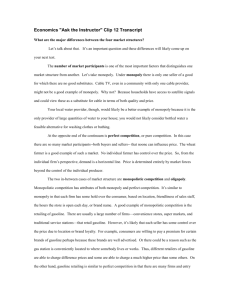Market Structures Test: Monopoly, Oligopoly, Competition
advertisement
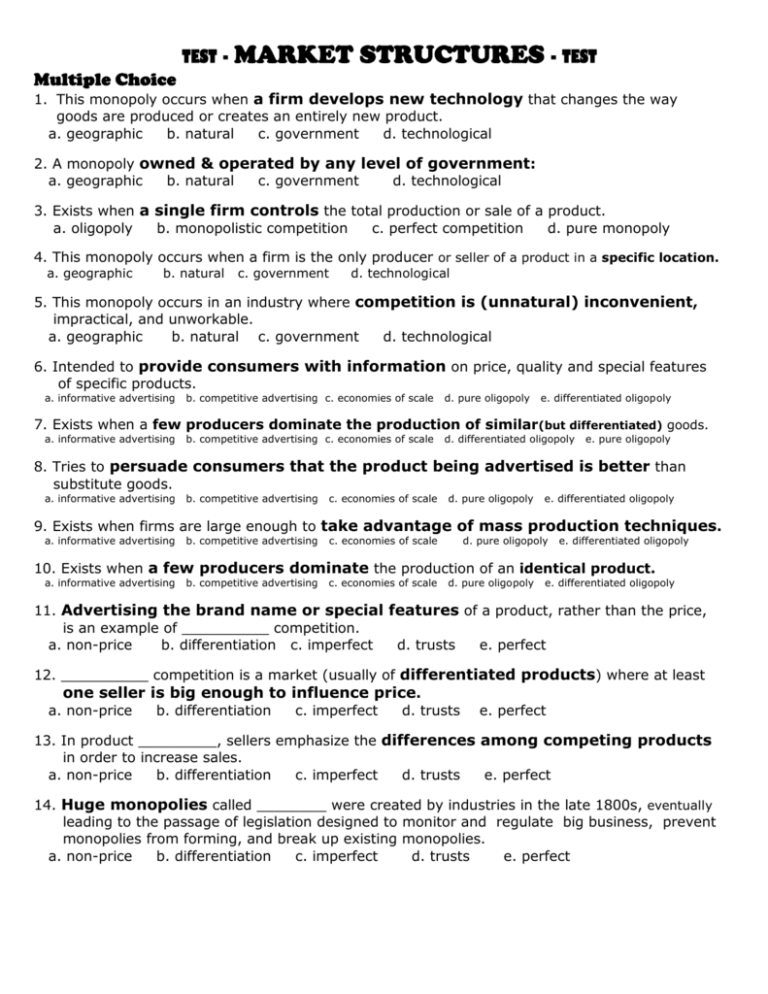
TEST - MARKET STRUCTURES - TEST Multiple Choice 1. This monopoly occurs when a firm develops new technology that changes the way goods are produced or creates an entirely new product. a. geographic b. natural c. government d. technological 2. A monopoly owned & operated by any level of government: a. geographic b. natural c. government d. technological 3. Exists when a single firm controls the total production or sale of a product. a. oligopoly b. monopolistic competition c. perfect competition d. pure monopoly 4. This monopoly occurs when a firm is the only producer or seller of a product in a specific location. a. geographic b. natural c. government d. technological 5. This monopoly occurs in an industry where competition is (unnatural) inconvenient, impractical, and unworkable. a. geographic b. natural c. government d. technological 6. Intended to provide consumers with information on price, quality and special features of specific products. a. informative advertising b. competitive advertising c. economies of scale d. pure oligopoly e. differentiated oligopoly 7. Exists when a few producers dominate the production of similar(but differentiated) goods. a. informative advertising b. competitive advertising c. economies of scale d. differentiated oligopoly e. pure oligopoly 8. Tries to persuade consumers that the product being advertised is better than substitute goods. a. informative advertising b. competitive advertising c. economies of scale d. pure oligopoly e. differentiated oligopoly 9. Exists when firms are large enough to take advantage of mass production techniques. a. informative advertising b. competitive advertising c. economies of scale d. pure oligopoly e. differentiated oligopoly 10. Exists when a few producers dominate the production of an identical product. a. informative advertising b. competitive advertising c. economies of scale d. pure oligopoly e. differentiated oligopoly 11. Advertising the brand name or special features of a product, rather than the price, is an example of __________ competition. a. non-price b. differentiation c. imperfect d. trusts e. perfect 12. __________ competition is a market (usually of differentiated products) where at least one seller is big enough to influence price. a. non-price b. differentiation c. imperfect d. trusts e. perfect 13. In product _________, sellers emphasize the differences among competing products in order to increase sales. a. non-price b. differentiation c. imperfect d. trusts e. perfect 14. Huge monopolies called ________ were created by industries in the late 1800s, eventually leading to the passage of legislation designed to monitor and regulate big business, prevent monopolies from forming, and break up existing monopolies. a. non-price b. differentiation c. imperfect d. trusts e. perfect 15. ________ competition is a market where sellers and buyers are so large (homogeneous[identical] products), that no seller can control price. a. non-price b. differentiation c. imperfect d. trusts e. perfect 16. Economists use the term ________ structure to describe how competitive specific industries are. a. copyright b. patent c. price d. market e. collusion 17. In oligopolies, ________ leadership often originates with the largest firm in an industry, which offers its new product at a certain price, hoping that the competing firms will set similar prices for their products. a. copyright b. patent c. price d. market e. collusion 18. A ________ gives authors, composers, and artists exclusive rights to publish, duplicate, perform, display, or sell their creative works. a. copyright b. patent c. price d. market e. collusion 19. A ________ grants a firm or individual the exclusive right to produce, use, or dispose of an invention or discovery for 17 years. a. copyright b. patent c. price d. market e. collusion 20. ________ occurs when leaders of competing firms illegally set prices or production levels for products. a. copyright b. patent c. price d. market e. collusion 21. The market structure that involves the most competition: a. perfect competition b. monopolistic competition c. oligopoly d. pure monopoly 22. All of the following are examples of pure oligopoly a. aluminum b. oil c. clothes dryers d. steel EXCEPT: 23. Each of the following is a product of a differentiated oligopoly a. lumber b. automobiles c. breakfast cereals EXCEPT: d. beer 24. Price leadership: a. exists only in pure monopolies b. exists in competition only among sole proprietorships c. is used in oligopolies to control the price of a good d. is illegal 25. The market structure with the most control over prices is: a. perfect competition b. monopolistic competition c. oligopoly d. pure monopoly 26. Each of the following is a condition necessary for the existence of perfect competition EXCEPT: a. the product must have many sellers and buyers available. b. the product being offered by one competing firm must be identical to those offered by other firms c. buyers must have easy access to information and prices available d. prohibitive barriers to entry in the industry must exist 27. An example of a positive externality would come from: a. smoking b. pollution c. education d. aircraft noise 28. The largest 3 or 4 firms in an industry produce 70% or more of the industry's total output, the industry is classified as: a. perfect competition b. pure monopoly c. monopolistic competition d. oligopoly 29. A firm that advertises that its products are made with higher quality and better workmanship than similar products made by other firms is engaged in: a. consumer fraud b. restraint of trade c. bandwagon advertising d. non-price competition 30. Which of the following is a product of a differentiated oligopoly? a. dairy products b. steel c. oil d. personal computers 31. Each of the following is a condition necessary for the existence of monopolistic competition EXCEPT: a. Fairly large number(25-75) buyers and sellers of the product must exist. b. Firms must offer identical products for sale. c. Buyers must be well informed about differentiated products. d. Firms must be able to enter or exit an industry with relative ease. 32. The market structure in which entry into the industry is the most prohibitive(hardest) is: a. perfect competition b. monopolistic competition c. oligopoly d. pure monopoly 33. All the following exist in an oligopoly EXCEPT: a. General Motors b. Ford Motor Company c. Chrysler Corporation d. Comcast Cable TV 34. Monopolies that exist in response to public needs that the private sector has not met: a. government b. technological c. geographic d. natural 35. Which of the following market structures has the largest number of firms trying to sell their products? a. perfect competition b. monopolistic competition c. oligopoly d. monopoly 36. Government legislation aimed at maintaining competition is termed: a. non-discriminatory b. regressive c. antitrust d. monopolistic e. comp-maintain 37. In monopolistic competitive markets, firms usually sell products that are: a. close substitutes b. completely different c. complementary d. identical 38. Which of the following laws first declared monopoly and restraint of trade illegal? a. Sherman Act b. Clayton Act c. Federal Trade Commission Act d. Celler Act 39. An example of a negative externality would be: a. education b. a guard-dog c. litterbugs d. dam TRUE-FALSE [“A” for True & “B” for False] 40. Polaroid has a geographic monopoly on instant cameras. 41. A patent is good for 25 years. 42. Public utilities(no government ownership) are an example of natural monopolies. 43. Patent infringement cases are always settled in a few days. 44. Rubik's Cube is an example of a geographic monopoly. 45. The Postal Service is a government monopoly. 46. A remote store would be an example of a technological monopoly. 47. A firm that is successful in developing brand name loyalty can marginally increase the price of the product without losing its customers. 48. An industry is classified as an oligopoly when two firms produce 98% of the industry's total output. 49. To encourage their production we subsidize positive externalities and to discourage their production we tax negative externalities. 50. Cable TV(privately owned company) would be an example of a government monopoly. Test 8 Market Structures [1-49]



